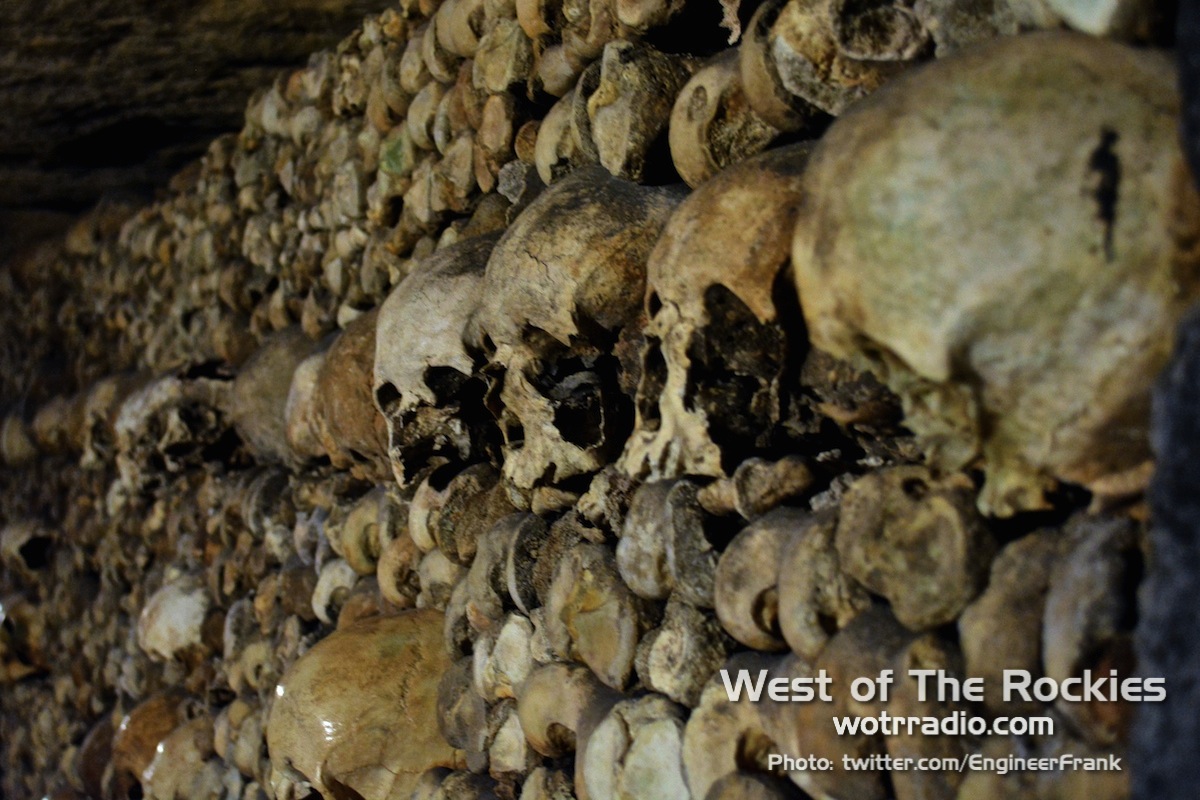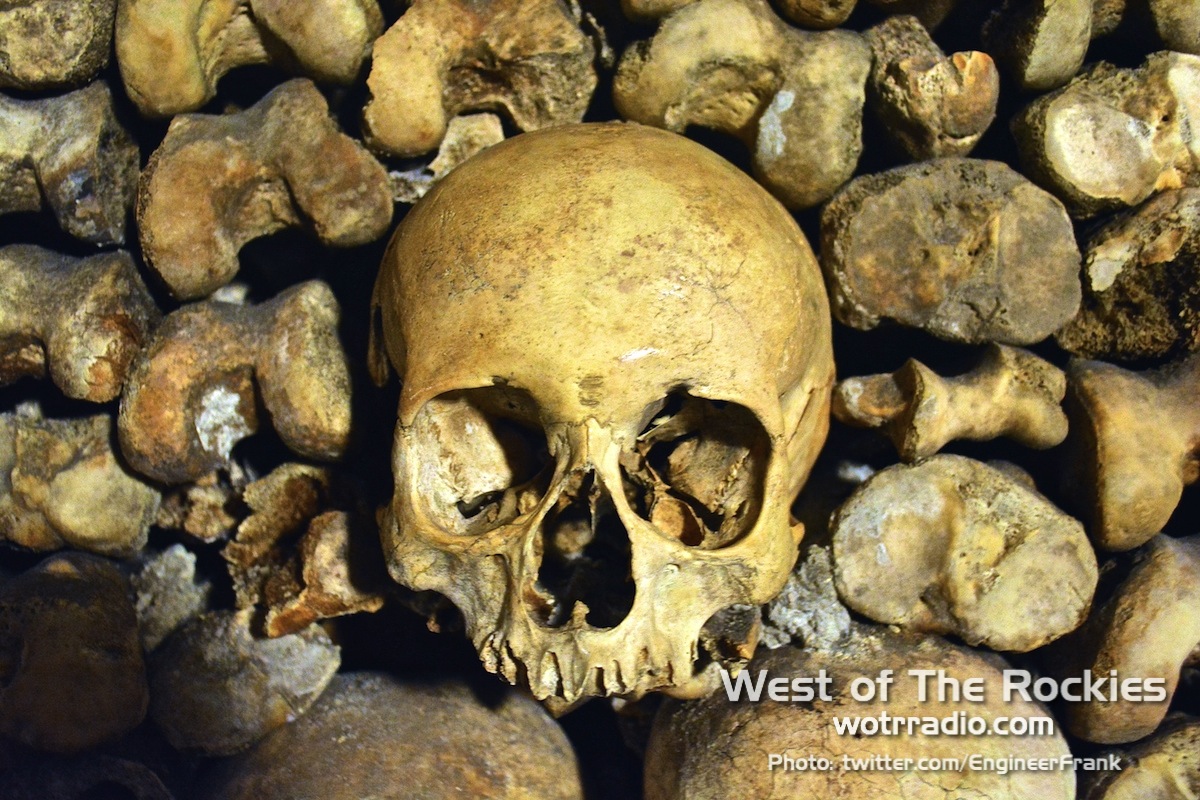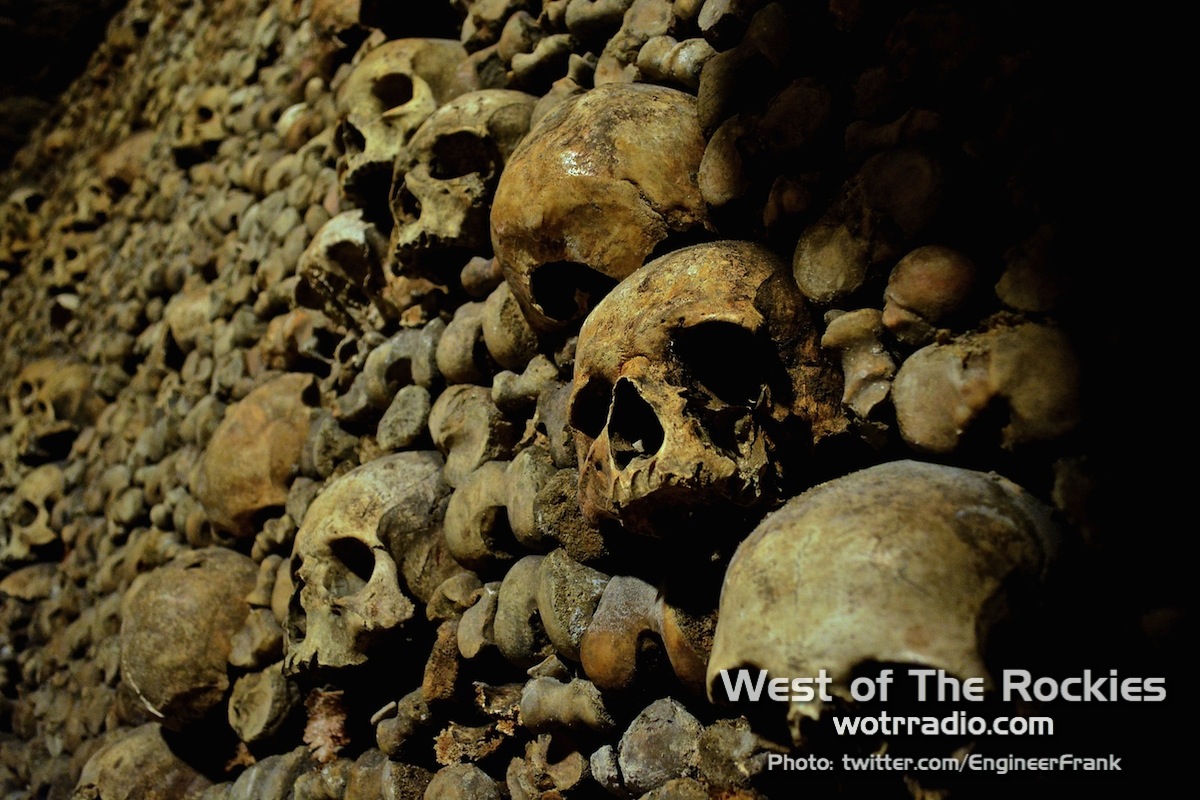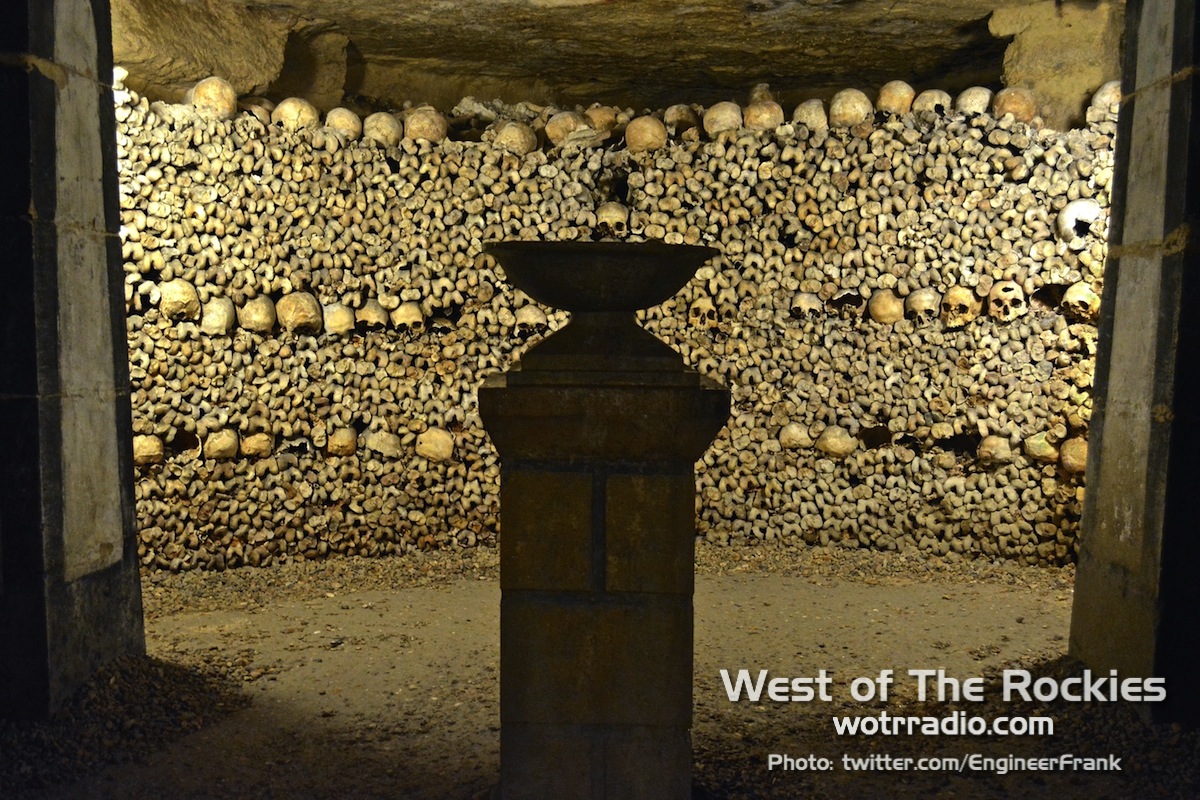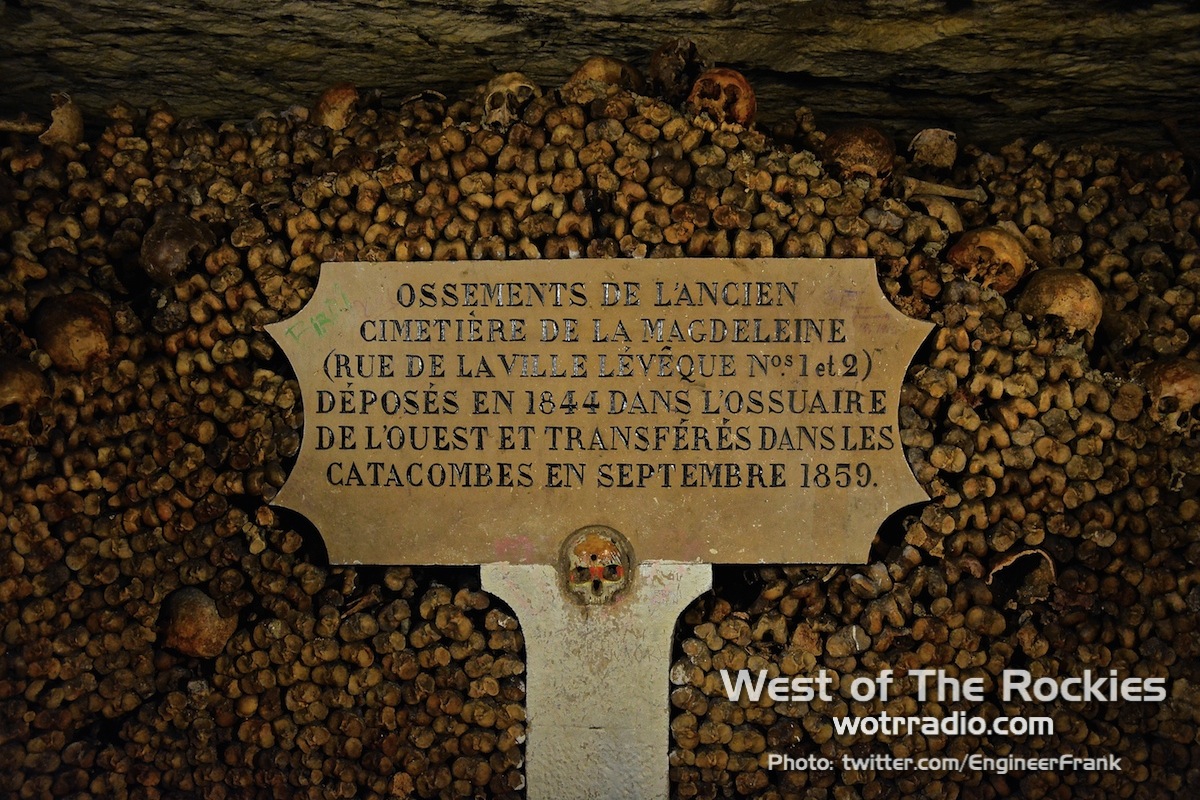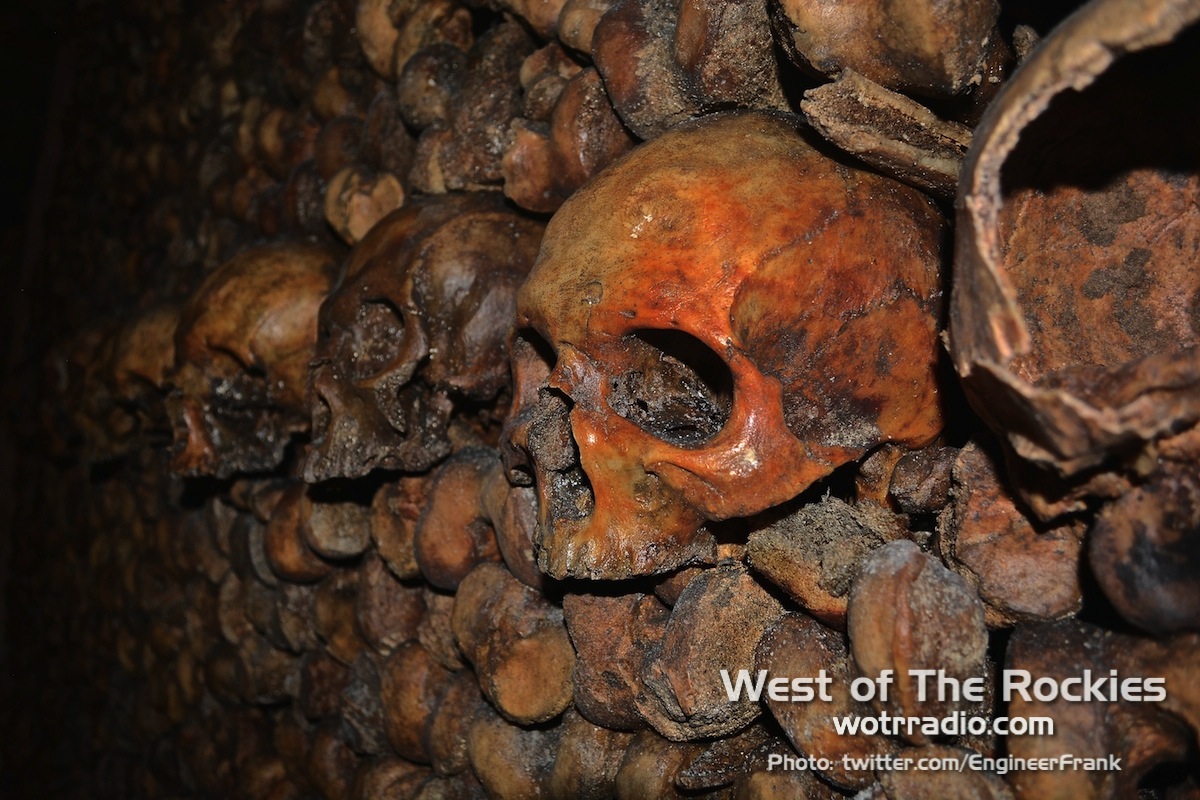Paris: the city of love, lights and laughter. Look a little further under ground though, and a whole other world is revealed. The Paris Catacombs have been the subject of many a mystery and urban legend in the past few decades, and have even been the focal point of a Hollywood movie, namely As Above, So Below. We ventured on a little trip to Paris this Spring, and were sure to put aside some time to check out the Paris Catacombs. Warm, musty and filled with tourists, it was nevertheless a fascinating experience. The few times we had a section of the walkway to ourselves, it was sombre and mesmerising. Here’s the account of our catacombs walk-through…
Skull patterns, sometimes to be found in the shape of stick-men and hearts. I mean, what else is there to do with millions of bones, right?
It’s Paris: there’s tourists everywhere, and there’s queues everywhere. So, naturally, we had to stand in line to get down into the Catacombs. In fact, it was so busy that I even managed to pop over to the pharmacy across the street in that time to grab some cough syrup (not that type of cough syrup…I actually had a bad cough). However, despite the throngs of people, I was surprised that I still managed to have several stretches of walkway all to myself, often for minutes at a time. I guess that’s testament to the expanse of this underground cemetery. All those who were involved in digging this: I do not envy you.
What you need to know is that actually only a small portion of this underground network is open to the public. Most areas are closed off and difficult to access, though of course that doesn’t stop everyone. People have been known to sneak down and hold full-on raves and parties; “cataphiles” host secret tours and investigations; and various societies organise art exhibitions and concerts. However, the most intricate discovery to-date surely has to be the secret cinema that was found by the police in 2004: completely equipped with giant screen and projection equipment, audience seats carved into the rock, plus a fully-stocked bar and restaurant. The people behind this set-up were never found (I would have loved to talk to them, I’m sure they had some great stories to tell!).
A breathtaking shot of one of the walkways...
The Paris Catacombs opened in the late 1700s, and started growing into a popular tourist attraction in the 1800s. Of course, there’s always been debate about whether such a place should even be open to the public – quite naturally, a lot of people find it distasteful to turn people’s bodily remains into a tourist attraction for entertainment purposes; the church has kicked up a fuss in the past on the grounds that the bones are sacred, which is also understandable.
Nevertheless, one cannot deny that the Catacombs are an extraordinary feat of art and engineering. Six million people’s bones, 200 miles of tunnels and caverns, and hundreds of dark and poetic quotes – the Paris Catacombs really are something else.
The main entrance to the Catacombs can be found at the Place Denfert-Rochereau, in the southern part of central Paris; however, this area was traditionally known as Place d’Enfer, which quite aptly means, “Hell Square.” Upon first entering through the main doors, one encounters the following message:
"Warning: The ossuary tour could make a strong impression on children and people of a nervous disposition."
While the imagery is undeniably dark and spooky, it’s strange to think that humans should be afraid of other human remains. I mean, we all have bones in our bodies, right? That should surely make us less afraid. On the other hand, I guess for a lot of visitors that “strong impression” is less one of fear, and more a realisation that life is extremely fragile, that all these bones were people with families and friends at one point…there’s definitely a strong chance of existential anxiety when down there amongst all those skeletal remains.
"Stop! Here lies the empire of death."
Why were the Catacombs built in the first place though? To summarise, Paris cemeteries were quite simply becoming overcrowded and ridiculously unhygienic, to the extent that they posed serious health hazards to the people living in the adjacent areas. Les Innocents, which can be found in the Les Halles neighbourhood of Paris, was the city’s first Christian cemetery, and would also become Paris’ most well-known. The bodies piled up over the centuries, with war and disease being the biggest contribution: in fact, the plague of 1418 saw 50,000 bodies added to Les Innocents within a mere five-week period. The hundred-years war brought many more. It was said that the area smelled so bad, that even perfume shops started going out of business. Just imagine that – a stench so awful that even perfume is overpowered. However, the final straw came in 1780, when a particularly rainy Spring season caused a cellar wall around Les Inncocents to collapse, resulting in a mass of decomposing corpses and diseased mud being spilled into a neighbouring property. Something needed to be done, and it needed to be done fast. Thus began a 12-year-long process of moving the city’s bones below ground, into Paris’ abandoned stone quarries. Not only were there millions of people’s bones, but they also dated back hundreds of years; some going as far back as 1,200 years, from an era known as the Merovingian period. Yes, it was a very big task.
Enough of the gruesome facts for now though, let us move on to my favourite part: the poetry. Various literary and Biblical quotes are dotted around the entire network at regular intervals – there’s something about them that completely transforms the experience…it’s as if there’s a narrator guiding you through the tunnels, giving you nuggets of wisdom and thought-provoking ideas to ponder as you amble through the catacombs. It’s truly great.
Here are a select handful of plaques that we encountered (excuse the awful formatting on certain devices...nowt to be done 'bout it):
(1)
(1)
Ainsi tout passe sur la terre
Esprit, beauté, graces talent
Telle est une fleur ephémère
Que renverse le moindre vent
Thus passes everything on earth
Spirit, beauty, talent, grace
Such is a short-lived flower
That’s blown away by the slightest breeze.
(2) OK, there was no good angle to take this at...
(2)
Ou est elle la Mort? toujours
future ou passée. Apeine est-elle
presente, que deja elle n’est plus.
Where is Death? eternal
in future or past. As soon as she
appears, she’s already gone.
This one. This one I especially like. Throughout this article, I’ve made sure to keep the translations in the best physical order possible, because I’ve seen a lot of translations that shuffle up the positioning of the words. That is, if a line ends with “toujours,” I’ll try my best to ensure that “always/eternal” is also at the end of the line. It’s important, honestly! Take the above quote. It begins with a question, “Where is death?” The word that immediately follows it is eternal (or “eternally,” “always,” “forever”…I wasn’t quite sure what to settle on). Giving “toujours” some space to itself really draws our attention to it; even though it is part of a sentence, it could be a sentence in itself – in a way, it answers the question, “Where is death?” quite well. Because death is indeed always there, it’s an eternal fact of life. However, then the stanza moves on to the next line, and the sentence concludes with, “in future or past,” giving us an alternate answer to the question. This time we are being told that death is fleeting, difficult to catch; somehow always in the past or future, but never quite in the present.
OK, enough of the English session – I just wanted to emphasise the depth of some of these poems and the importance of accurate translations. Now back to skulls and stuff.
(3) Somewhat grim, yes.
(3)
Quocumque te vertas mors’in insidiis est
Dequelque coté que tu tournes la mort est aux aguets
Whichever way you turn, death’ll be waiting for you.
(4) "YOLO."
(4)
Omne crede diem tibi diluxisse supremum
Croyez que chaque jour est pour vous le dernier.
Hórace
Think that every day will be your last.
(5) Those graffiti etchings? Absolutely blasphemous.
(5)
Heureux celui qui a toujours
devant les yeux l’heure de sa mort et
qui se dispose tous les jours à mourir
Blessed is he who keeps ever in sight
the hour of his death and
is always ready to die
(6)
(6)
Si vous avez vu quelque fois mourir
un homme, considérez tojours
que le meme sort vous attend
If at times you’ve seen the death of
a man, remember always
that the same fate awaits you
(7)
(7)
Quels enclos sont ouverts! quelles étroîtes places
Occupe entre ces murs la poussière des races!
C’est dans ces lieux d’oubli, C’est parmi ces tombeaux
Que le temps et la mort viennent croiser leurs faux
Que de morts entassés et presses sous la terre!
Le nombre ici n’est rien la foule est solitaire.
Lemierre
What enclosures are open! what narrow places
Occupied between these walls, the dust of the races!
It’s in these forgotten areas, It is among these tombs
That time and death come to cross their scythes
That the dead, piled high and pressed ’neath the earth!
The number here is nothing, the crowd is solitary.
(8)
(8)
Mihi…mori lucrum.
Phil. 1. 21.
Pour moi
la mort est un gain.
For me…to die is a gain.
(9)
(9)
Eleemosyna
a morte liberat.
Tob. 12. 9.
L’aumone
délivre de la mort.
Charity
delivers from death.
(10)
(10)
Melius est mihi mori quam vivere.
Joan. 4. 8
Il est quelquefois
plus avantageux
de mourir que de vivre
It is sometimes better to die than to live.
(11)
(11)
isi granum mortuum fuerit
Ipsum solum manet;
Si autem mortuum fuerit
Multum fructum affert.
Joan. 12. 24. 25
Unless the grain dies
It remains alone;
But if it were to die
It would bring forth much fruit.
(12)
(12)
idi impium suprexaltatum et elevatum
sicut cedros libani; et transivi et ecce non erat;
et quæasivi eum et non inventus est locus eius.
Psaumes de David Ch. XXXVI
J’ai vu l’impie adoré sur la terre.
Pareil au cèdre il cachoit dans les cieux
Son front audacieux
Il semblait à son gré gouverner le tonnerre,
Foulait aux pieds ses ennemis vaincus;
Je n’ai fait que passer, il n’était déjà plus.
Racine
The Unreightous I behold on Earth ador’d;
And as the Cedar to the Heavens spread
His towering and presumptuous Head.
He seem’d as at his Nod the Thunder roar’d:
His Enemis were Dust beneath his Might;
Passing I turn’d, I lookt, and he was vanisht quite.
(13)
(13)
Ainsi tout change, ainsi tout passé;
Ainsi nous-mêmes nous passons,
Hélas! Sans laisser plus de trâce
Que cette barque où nous glissons
Sur cette mer où tout s’efface.
LaMartine
(14)
Thus all changes, thus all passes;
So, ourselves, we pass,
Alas! Without leaving any a trace
That this boat where we glide
On this sea where all disappears.
(14)
Deposuit potentes de sede
Et exaltavit humiles.
St. Luc. Ch 1.
Il a renversé les grands de leurs trônes
et il a élevé les petits.
He has put down the mighty from their seats,
and exalted them of low degree.
(15)
(15)
Mort
peccatorum pessima
Ps. 38. 22.
Elle est horrible
la mort du pécheur.
(16)
Death
of the sinner is the worst
(16)
Reliquit dives omnia
aliis et moritur.
Eccl. 11. 20.
A la mort,
on laisse tout.
To death,
we relinquish all.
(17)
(17)
Invidiâ diaboli
mors introïvit in orbem
Gen. ch. 3.
C’est par la malice de demon
que la mort
est entrée dans la monde.
(18)
‘Tis by the devil’s envy
death came into the world.
(18)
Insensés: nous parlons en maîtres,
Nous qui dans l’océan des êtres,
Nageons tristement confondus;
Nous dont l’extistence légère,
Paraeille à l’ombre passagère,
Commence, paroît et n’est plus.
Malfilatre
Fools: we speak as masters,
We, who in the ocean of being,
swim unfortunately confused;
We, whose light existence,
Comparable to the passing shadow,
Begins, appears and is no longer.
(19) A sound reminder that we create our own fate...
(19)
Deus mortem non fecit
SAP. 1. 13.
Dieu n’est pas
l’auteur de la mort
God is not
the author of death
(20)
(20)
Combien de ceux qui étaient entrés
dans le monde avec toi en sont déjà
fortis; leur vie a été moissonnée
Comme des épis dont les uns
font murs et les autres verts.
Marc. Aurel
How many of those who entered
the world with you are already
strong; their life has been harvested
Like the ears of those
that build walls and make others envious.
(21)
(21)
Stimulus autem
mortis peccatum est.
1. Cor. 15. 56.
L’aiguillon de la mort
c’est le pêché.
The sting
of death, ‘tis a sin.
(22)
(22)
Mors te manet certissima;
In certa sed mortis dies.
Ut mente semper excubus,
Homo latet lux ultima.
Hézette.
Death awaits you most surely;
In certainty but the day of death,
From always keeping our mind on guard,
Man escapes the last light.
Alas, that’s all for now. Want a little more of the Paris Catacombs? Maybe start by checking out the apparent mystery camera that was discovered in the depth of the catacombs. As the urban legend goes, an abandoned camera was found in the catacombs and, upon watching it, it appears that the cameraman became frightened for some reason and dropped the camera, with his footsteps being heard running off into the distance. It’s a modern mystery – though it does undeniably reek of a fake, it’s still fun to ponder.
Would you ever sneak into the catacombs on your own? Would you be brave enough to spend a night there? Would you have entered this AirBnB competition to experience a night in the catacombs? Apparently Pedro Arruda was, boldy claiming that, “I’d be much more scared if they were alive.”
And honestly? I think we have much more reason to be afraid of humans when they’re alive than when they are dead…
For those of you that like the visuals as much as we do, enjoy our slideshow:










